Analysis of the Exhaust Emissions of Hybrid Vehicles for the Current and Future RDE Driving Cycle
Abstract
:1. Introduction
2. Literature Review
- characteristics of local research routes;
- small sample of research data collected from a small population of cars;
- too little difference between the different phases of the research route.
- low ambient temperature;
- varied slope of the road;
- similarity of phase contribution in the test;
- diverse dynamic conditions;
- using other computational algorithms (MAW, raw data);
- measurement uncertainty of the instruments used (drift of the analyzer over time and exhaust flow rate).
- introduction of limits for other pollutants (NH3, N2O, CH4, PN D < 23 nm) [43];
- use of RDE route generators (locally), enabling greater discretization of vehicle operating conditions [44];
- short urban driving limits [45];
- reduced conformity factor for all compounds [46];
- reducing the conformity factor for NOx to a value of 1.1 [22];
- the vehicle should be zero or near zero emissions in urban areas, and this should be guaranteed via a combination of RDE and OBD [9];
- inclusion of the first engine start in the motorway phase for vehicles PHEV;
- developing the RDE+ concept (a virtual tool combining environmental conditions, test equipment and the ability to test a vehicle under dynamometer conditions) [44].
| References | Vehicle | Euro Class | Test | Distance(km) | Time (min) | Urban | Rural | Motorway | |||
|---|---|---|---|---|---|---|---|---|---|---|---|
| (km) | (%) | (km) | (%) | (km) | (%) | ||||||
| Lejda et al. [42] | gasoline, CNG | Euro 3 | Non-RDE | 32.9 | 39.9 | 11 | 33.4 | 10.1 | 30.7 | 11.8 | 35.8 |
| Šarkan et al. [36] | gasoline, LPG | Euro 4 | RDE | 69.4 | 95 | 21.5 | 31 | 26.5 | 38 | 21.4 | 31 |
| Pignatta et al. [35] | gasoline | Euro 4 | Urban | 2.2 | 4.7 | 2.2 | |||||
| Du et al. [47] | gasoline | Euro 4 | RDE | 75.4 | 24.6 | 32.6 | 24.4 | 32.4 | 26.4 | 35 | |
| Akard et al. [51] | gasoline | Euro 4 | Non-RDE | 37.4–39.9 | |||||||
| Bodisco and Zare [52] | gasoline | Euro 6 | RDE | 88.6 | 26.8 | 30.3 | 25.1 | 28.3 | 36.7 | 41.4 | |
| Kadijk et al. [53] | diesel | Euro 5b | RDE | 71.9 | 105.6 | ||||||
| diesel | Euro 6 | RDE | 70.3–75.2 | 96.6–108.1 | |||||||
| diesel | Euro 6b | RDE | 69.1–69.8 | 93.6–107.6 | |||||||
| Yang et al. [17] | gasoline, diesel | Euro 6b | Non-RDE | 59.6 | 19.1 | 32 | 22.7 | 29.3 | 17.7 | 29.7 | |
| Winther et al. [39] | gasoline, diesel | Euro 6b | RDE | 84.7 | 96 | 32.9 | 39 | 32 | 38 | 19.8 | 23 |
| diesel | Euro 6 | RDE | 85 | 42 | 31 | 27 | |||||
| diesel | Euro 6 | City | 40 | 90 | 10 | ||||||
| diesel | Euro 6 | Motorway | 104 | 17 | 53 | 30 | |||||
| diesel, gasoline | Euro 6 | RDE | 90 | 90–120 | |||||||
| gasoline, hybrid | Euro 6 | RDE | 96 | 101 | 34.5 | 35.5 | 30 | ||||
| gasoline, hybrid | Euro 6 | Non-RDE | 38 | 41 | 35.7 | 34.2 | 30 | ||||
| Ziółkowski et al. [10] | hybrid | Euro 6c | RDE | 70.3 | 91 | 29.7 | 42.5 | 17.7 | 24.9 | 22.9 | 32.6 |
| Prati et al. [34] | plug-in hybrid | Euro 6 | RDE | 57.9–66.4 | 92.2–105.5 | 19.1–22.4 | 30.7–36.2 | 19.2–21.9 | 30.5–35.5 | 17.8–22.9 | 29.3–38.7 |
| plug-in hybrid | Euro 6 | Urban | 25.1–26.7 | 77.7–85.2 | 25.1–26.7 | 100 | |||||
| Sokolnicka et al. [54] | gasoline | Euro 6 | RDE | 79.2 | 109.6 | 34.2 | 19.5 | 25.5 | |||
| Suarez-Bertoa et al. [24] | gasoline, diesel | Euro 6b–Euro 6d -temp | RDE | 79–94 | 98–112 | 32–37 | 25–27 | 22–30 | |||
| Giechaskiel et al. [25] | gasoline | Euro 6d -temp-Evap | RDE | 96–99 | 111–114 | 26.5–27.8 | 23.8–24.3 | ||||
| gasoline | Euro 6d -temp-Evap | RDE short | 50 | 60 | 12.8 | 25.6 | |||||
| gasoline | Euro 6d -temp-Evap | RDE | 100 | 118 | 38.5 | 38.5 | |||||
| Suarez-Berota et al. [42] | gasoline, diesel, CNG | Euro 6–Euro 6d -temp | RDE | 79–104 | 94–114 | 31–41 | 25–29 | 23–34 | |||
| Suarez-Bertoa et al. [33] | gasoline, diesel, CNG | Euro 6–Euro 6d -temp | RDE | 79–94 | 98–112 | 32–37 | 33–40 | 25–27 | 29–32 | 22–30 | 28–32 |
| gasoline, diesel, CNG | Euro 6–Euro 6d -temp | Non-RDE | 79–94 | 94–104 | 31–34 | 36–39 | 25–28 | 27–32 | 23–32 | 29–34 | |
| gasoline, diesel, CNG | Euro 6–Euro 6d -temp | Motorway | 139 | 136 | 44 | 32 | 18 | 13 | 80 | 58 | |
| gasoline, diesel, CNG | Euro 6–Euro 6d -temp | Hill | 61 | 106 | 61 | 100 | |||||
| Luján et al. [40] | diesel | Euro 6 | RDE (engine test bench) | 90.9–94.9 | 21.6–25.9 | 32.9–36.4 | 22.3–27.9 | 33.9–39.2 | 17.4–20.5 | 39.2–37.0 | |
| Selleri et al. [55] | diesel | Euro 6d-ISC | RDE | 91.1 | 103 | 35.5 | 39 | 29.1 | 32 | 26.5 | 29 |
| diesel | Euro 6d-ISC | Motorway | 187.7 | 117 | 15.0 | 8 | 18.1 | 9.6 | 154.6 | 82.4 | |
| diesel | Euro 6d-ISC | City | 129.2 | 116 | 33.9 | 26.2 | 12.5 | 9.6 | 82.9 | 64.2 | |
| Soo Yu et al. [56] | diesel | Euro 6d -temp | RDE | 73.9 | 103.1 | 26.5 | 36.0 | 19.7 | 26.8 | 27.4 | 37.2 |
| Pielecha et al. [50] | gasoline | Euro 6d -temp | RDE | 99.7–100.2 | 101.7–105.3 | 32.1–35.4 | 32.0–34.8 | 31.9–34.6 | 32.0–34.6 | 33.1–33.3 | 32.5–33.4 |
| hybrid | Euro 6d -temp | RDE | 96.6–97.4 | 101.3–109.2 | 31.2–33.9 | 32.3–34.9 | 30.8–32.1 | 31.6–33.2 | 32.3–34.4 | 33.3–35.3 | |
| electric | Euro 6d -temp | RDE | 96.1–98.5 | 103.3–106 | 32.4–34.5 | 33.7–35.0 | 31.2–31.4 | 31.7–32.7 | 32.2–32.8 | 33.3–33.6 | |
| Skobiej and Pielecha [49] | plug-in hybrid | Euro 6d -temp | RDE | 91.9–97.4 | 104.5–107.8 | 32.2–33.7 | 33.1–36.7 | 25.6–31.6 | 27.5–32.7 | 32.0–34.4 | 33.2–35.8 |
| Wang et al. [57] | gasoline, hybrid | China-6 | RDE | 76.6 | 95.4–115 | 23.9–24.9 | 24.0–24.6 | 27.1–28.7 | |||
3. Purpose of Article
4. Research Methodology
4.1. Research Routes
- RDE compliant (as RDE-Compliant);
- Non-RDE compliant, length 16 km (as RDE 16 km);
- Non-RDE compliant, length 8 km (as RDE 8 km)
- the share of the urban phase varied by 33–36%;
- the share of the rural phase varied by 29–34%;
- the share of the motorway phase varied by 32–35%.
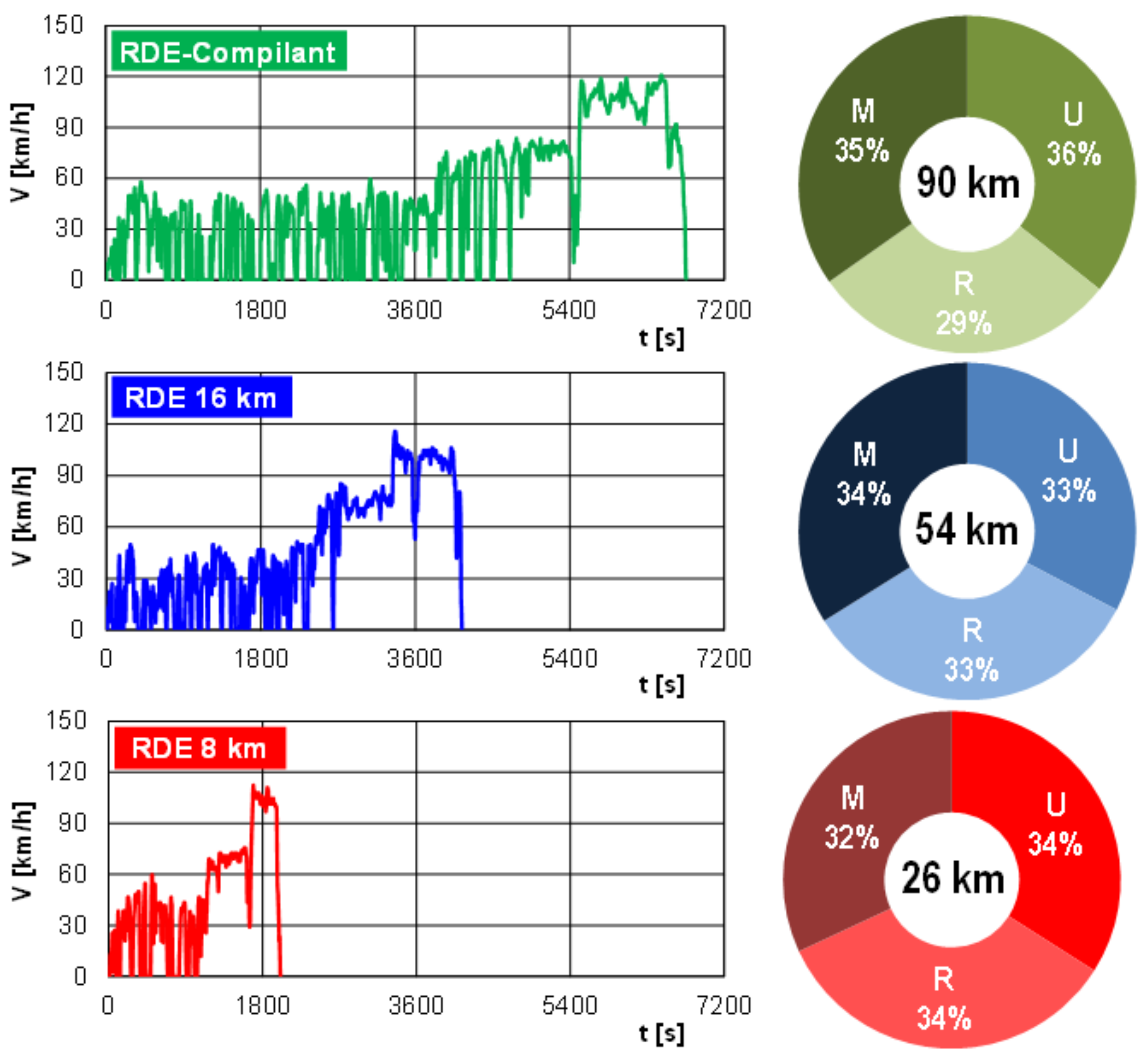
4.2. Research Object
4.3. Research Equipment
5. Results and Discussion
5.1. Assessment of Dynamic Conditions
- for the urban part: 10.5 ± 2.5 m2/s3;
- for the rural part: 13 ± 4 m2/s3;
- for the motorway part: 13 ± 2 m2/s3.
- at different values of average speed in a given phase.
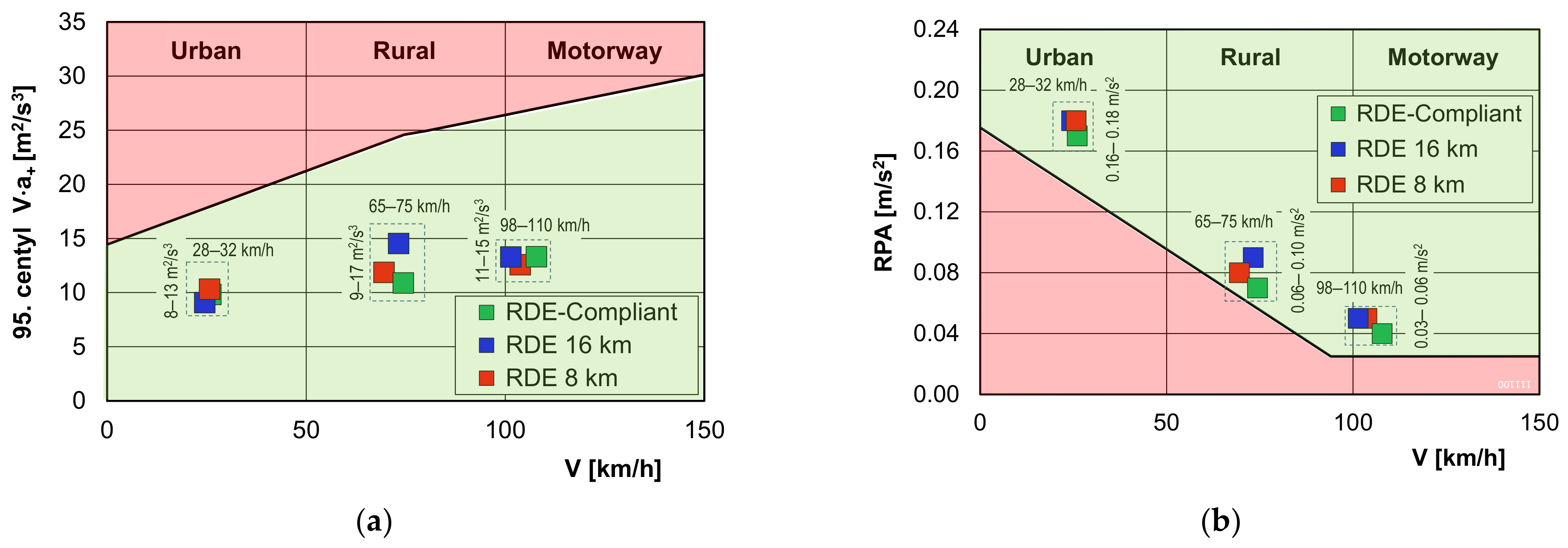
- for the urban part: 0.17 ± 0.1 m/s2;
- for the rural part: 0.08 ± 0.2 m/s2;
- for the motorway part: 0.045 ± 0.015 m/s2.
5.2. Comparison of Exhaust Emissions
- for the test RDE-Compliant: 100% (Urban), 74.0% (Rural) and 100% (Motorway);
- for the test RDE 16 km: 100% (Urban), 85.4% (Rural) and 100% (Motorway);
- for the test RDE 8 km: 100% (Urban), 93.2% (Rural) and 64.3% (Motorway).

6. Results and Discussion
7. Conclusions
Author Contributions
Funding
Data Availability Statement
Conflicts of Interest
Abbreviations
| a | acceleration vehicle |
| CF | conformity factor |
| CNG | compressed natural gas |
| EE | exhaust emission |
| HEV | hybrid electric vehicle |
| ICE | internal combustion engines |
| JRC | Joint Research Centre |
| LPG | liquefied petroleum gas |
| M | motorway |
| MAW | moving average window |
| NEDC | New European Driving Cycle |
| NMHC | non-methane hydrocarbons |
| OBD | on-board diagnostic |
| PEMS | portable emission measurement system |
| PHEV | plug-in hybrid electric vehicle |
| PN | particle number |
| R | rural |
| RDE | real driving emissions |
| RPA | relative positive acceleration |
| S | distance |
| SOC | state of charge |
| t | time |
| TCMV | Technical Committee on Motor Vehicles |
| u | share |
| U | urban |
| V | vehicle speed |
| WHO | World Health Organization |
| WLTC | Worldwide harmonized Light-duty vehicles Test Cycle |
| WLTP | Worldwide harmonized Light-duty vehicles Test Procedure |
Appendix A
| Parameter | RDE Requirements | RDE-Compliant | RDE 16 km | RDE 8 km |
|---|---|---|---|---|
| Distance | ||||
| Urban | >16 km | 31.95 km | 17.70 km | 8.90 km |
| Rural | >16 km | 26.49 km | 18.08 km | 8.92 km |
| Motorway | >16 km | 31.15 km | 18.34 km | 8.36 km |
| Trip composition | ||||
| Urban | 29–44% | 35.66% | 32.71% | 34.02% |
| Rural | 23–43% | 29.57% | 33.41% | 34.06% |
| Motorway | 23–43% | 34.77% | 33.89% | 31.95% |
| Average urban speed | 15–40 km/h | 26.00 km/h | 24.53 km/h | 25.73 km/h |
| Average rural speed | 74.39 km/h | 73.28 km/h | 69.51 km/h | |
| Average motorway speed | 107.82 km/h | 101.4 km/h | 103.73 km/h | |
| Average test speed | 47.81 km/h | 47.10 km/h | 47.17 km/h | |
| Stop (urban driving time) | 6–30% | 21.99% | 18.79% | 20.48% |
| Dynamics | ||||
| 95th percentile v·a+ | ||||
| Urban | 9.83 m2/s3 | 9.08 m2/s3 | 10.32 m2/s3 | |
| Rural | 10.89 m2/s3 | 14.54 m2/s3 | 11.87 m2/s3 | |
| Motorway | 13.32 m2/s3 | 13.29 m2/s3 | 12.58 m2/s3 | |
| Relative positive acceleration | ||||
| Urban | 0.17 m/s2 | 0.18 m/s2 | 0.18 m/s2 | |
| Rural | 0.07 m/s2 | 0.09 m/s2 | 0.08 m/s2 | |
| Motorway | 0.04 m/s2 | 0.05 m/s2 | 0.05 m/s2 | |
| Total trip duration | 90–120 min | 112.43 min | 68.93 min | 33.27 min |
References
- World Health Organization; Regional Office for Europe. Air Quality Guidelines for Europe; WHO Regional Office for Europe: Copenhagen, Denmark, 1987; p. 23. Available online: https://apps.who.int/iris/handle/10665/107364 (accessed on 25 June 2022).
- WHO Global Air Quality Guidelines. Particulate Matter (PM2.5 and PM10), Ozone, Nitrogen Dioxide, Sulfur Dioxide and Carbon Monoxide; WHO Regional Office for Europe: Bonn, Germany, 2021. Available online: https://apps.who.int/iris/handle/10665/345329 (accessed on 27 June 2022).
- Monforti-Ferrario, F.; Borowiak, A.; Putaud, J.P.; Perez Ballesta, P.; Cavalli, F.; Manca, G. Air Pollutants of Emerging Concern. Potential Air Pollutants and How They Could Be Monitored under Future Air Quality Directives; Joint Research Centre, Publications Office of the European Union: Luxembourg, 2022. [CrossRef]
- European Commission. Communication from the Commission to the European Parliament, the Council, the European Economic and Social Committee and the Committee of the Regions. Pathway to a Healthy Planet for All. EU Action Plan: Towards Zero Pollution for Air, Water and Soil. Brussels. 2021. Available online: https://ec.europa.eu/environment/pdf/zero-pollution-action-plan/communication_en.pdf (accessed on 25 June 2022).
- Lodi, C.; Serra, S.; Currò, D.; Gil-Sayas, S.; Marotta, A.; Bonnel, P.; Riemersma, I. Eco-Innovative Technologies Reducing CO2 Emissions of Light-Duty Vehicles: Evaluation of Interactions; Joint Research Centre, Publications Office of the European Union: Luxembourg, 2022. [CrossRef]
- Ktistakis, M.A.; Pavlovic, J.; Fontaras, G. Sampling Approaches for Road Vehicle Fuel Consumption Monitoring; European Commission, Joint Research Centre: Luxembourg, 2021. [CrossRef]
- European Union. Regulation (EU) 2019/631 of the European Parliament and of the Council of 17 April 2019 setting CO2 emission performance standards for new passenger cars and for new light commercial vehicles, and repealing Regulations (EC) No 443/2009 and (EU) No 510/2011. Off. J. Eur. Union 2019, L111. Available online: http://data.europa.eu/eli/reg/2019/631/oj (accessed on 20 January 2022).
- Rodríguez Quintero, R.; Vidal-Abarca Garrido, C. Revision of the EU Green Public Procurement Criteria for Road Transport: Technical Report and Criteria Proposal; Joint Research Centre, Publications Office of the European Union: Luxembourg, 2022. [CrossRef]
- Samaras, Z. Study on Post-EURO 6/VI Emission Standards in Europe (Part A). Update on the Draft Deliverables. Presentation to the Advisory Group on Vehicle Emission Standards (AGVES). Brussels. 2020. Available online: https://circabc.europa.eu/sd/a/a108e064-c487-4bf6-bb46-7faac76f8205/Post-EURO%206%20WT2.2_AGVES_2019_10_18%20V4.pdf (accessed on 25 May 2022).
- Ziolkowski, A.; Daszkiewicz, P.; Rymaniak, L.; Fuc, P.; Ukleja, P. Analysis of the Exhaust Emissions from Hybrid Vehicle during RDE Test. MATEC Web Conf. 2019, 294, 02002. [Google Scholar] [CrossRef]
- European Union. Commission Regulation (EU) 2017/1151 of 1 June 2017 Supplementing Regulation (EC) No 715/2007 of the European Parliament and of the Council on Type-Approval of Motor Vehicles with Respect to Emissions from Light Passenger and Commercial Vehicles (Euro 5 and Euro 6) and on Access to Vehicle Repair and Maintenance Information, Amending Directive 2007/46/EC of the European Parliament and of the Council, Commission Regulation (EC) No 692/2008 and Commission Regulation (EU) No 1230/2012 and Repealing Commission Regulation (EC) No 692/2008. Off. J. Eur. Union 2017, L175. Available online: http://data.europa.eu/eli/reg/2017/1151/oj (accessed on 12 May 2022).
- Zardini, A.; Bonnel, P. Real Driving Emissions Regulation: European Methodology to Fine Tune the EU Real Driving Emissions Data Evaluation Method; Joint Research Centre, Publications Office of the European Union: Luxembourg, 2020. [CrossRef]
- Gis, M. Assessment of Exhaust Emissions from Vehicles in Real Traffic Conditions. IOP Conf. Ser. Earth Environ. 2019, 214, 012035. [Google Scholar] [CrossRef]
- Du, B.; Zhang, L.; Geng, Y.; Zhang, Y.; Xu, H.; Xiang, G. Testing and Evaluation of Cold-Start Emissions in a Real Driving Emissions Test. Transp. Res. D Transp. Environ. 2020, 86, 102447. [Google Scholar] [CrossRef]
- Gioria, R.; Martini, G.; Perujo Mateos Del Parque, A.; Giechaskiel, B.; Carriero, M.; Zappia, A.; Cadario, M.; Forloni, F.; Lähde, T.; Selleri, T.; et al. Assessment of On-Road Emissions of Refuse Collection Vehicles: Diesel and Compressed Natural Gas; Joint Research Centre, Publications Office of the European Union: Luxembourg, 2020. [CrossRef]
- Bernard, Y. Current Situation and Perspectives on Vehicles Real-World Emissions. Bruxelles Environnement—Colloque de Présentation de La Fin de La Consultation Sur La Sortie Des Moteurs Thermiques. The International Council on Clean transportation. 2019. Available online: https://environnement.brussels/sites/default/files/user_files/pres_20190423_colloquesortiethermique_icct.pdf (accessed on 15 June 2022).
- Yang, Z.; Liu, Y.; Wu, L.; Martinet, S.; Zhang, Y.; Andre, M.; Mao, H. Real-World Gaseous Emission Characteristics of Euro 6b Light-Duty Gasoline- and Diesel-Fueled Vehicles. Transp. Res. D Transp. Environ. 2020, 78, 102215. [Google Scholar] [CrossRef]
- European Union. Commission Regulation (EU) 2016/427 of 10 March 2016 amending Regulation (EC) No 692/2008 as regards emissions from light passenger and commercial vehicles (Euro 6). Off. J. Eur. Union 2016, L82. Available online: http://data.europa.eu/eli/reg/2016/427/oj (accessed on 17 May 2022).
- European Union. Commission Regulation (EU) 2016/646 of 20 April 2016 amending Regulation (EC) No 692/2008 as regards emissions from light passenger and commercial vehicles (Euro 6). Off. J. Eur. Union 2016, L109. Available online: http://data.europa.eu/eli/reg/2016/646/oj (accessed on 19 May 2022).
- European Union. Commission Regulation (EU) 2018/1832 of 5 November 2018 amending Directive 2007/46/EC of the European Parliament and of the Council, Commission Regulation (EC) No 692/2008 and Commission Regulation (EU) 2017/1151 for the purpose of improving the emission type approval tests and procedures for light passenger and commercial vehicles, including those for in-service conformity and real-driving emissions and introducing devices for monitoring the consumption of fuel and electric energy. Off. J. Eur. Union 2018, L301. Available online: http://data.europa.eu/eli/reg/2018/1832/oj (accessed on 25 May 2022).
- EU TCMV Approves Euro 6e Amendments. DieselNet.com. Available online: https://dieselnet.com/news/2022/08tcmv.php (accessed on 25 August 2022).
- Giechaskiel, B.; Valverde, V.; Clairotte, M. Real Driving Emissions (RDE): 2020 Assessment of Portable Emissions Measurement Systems (PEMS) Measurement Uncertainty; Joint Research Centre, Publications Office of the European Union: Luxembourg, 2021. [CrossRef]
- Bonnel, P.; Clairotte, M.; Cotogno, G.; Gruening, C.; Loos, R.; Manara, D.; Melas, A.; Selleri, T.; Tutuianu, M.; Valverde, V.; et al. European Market Surveillance of Motor Vehicles. Results of the 2020-2021 European Commission Vehicle Emissions Testing Programme; Joint Research Centre, Publications Office of the European Union: Luxembourg, 2022. [CrossRef]
- Suarez-Bertoa, R.; Astorga, C.; Franco, V.; Kregar, Z.; Valverde, V.; Clairotte, M.; Pavlovic, J.; Giechaskiel, B. On-Road Vehicle Emissions beyond RDE Conditions: Experimental Assessment Addressing EU Real-Driving Emission (RDE); Joint Research Centre, Publications Office of the European Union: Luxembourg, 2019. [CrossRef]
- Giechaskiel, B.; Valverde, V.; Kontses, A.; Suarez-Bertoa, R.; Selleri, T.; Melas, A.; Otura, M.; Ferrarese, C.; Martini, G.; Balazs, A.; et al. Effect of Extreme Temperatures and Driving Conditions on Gaseous Pollutants of a Euro 6d-Temp Gasoline Vehicle. Atmosphere 2021, 12, 1011. [Google Scholar] [CrossRef]
- Alonso Raposo, M.; Mourtzouchou, A.; Garus, A.; Brinkhoff-Button, N.; Kert, K.; Ciuffo, B. JRC Future Mobility Solutions Living Lab (FMS-Lab): Conceptual Framework, State of Play and Way Forward; Joint Research Centre, Publications Office of the European Union: Luxembourg, 2021. [CrossRef]
- Mera, Z.; Fonseca, N.; López, J.M.; Casanova, J. Analysis of the High Instantaneous NOx Emissions from Euro 6 Diesel Passenger Cars under Real Driving Conditions. Appl. Energy 2019, 242, 1074–1089. [Google Scholar] [CrossRef]
- Claßen, J.; Krysmon, S.; Dorscheidt, F.; Sterlepper, S.; Pischinger, S. Real Driving Emission Calibration—Review of Current Validation Methods against the Background of Future Emission Legislation. Appl. Sci. 2021, 11, 5429. [Google Scholar] [CrossRef]
- Demuynck, J. Advanced Emission Controls and Renewable Fuels for Low Pollutants and Lifecycle CO2 Emissions. Sustainable Internal Combustion Engine Virtual ‘Live’, AECC Presentation. 2021, p. 210204. Available online: https://www.aecc.eu/wp-content/uploads/2021/02/210204-AECC-presentation-sustainable-ICE-conference-final.pdf (accessed on 20 August 2022).
- Winkler, S.L.; Anderson, J.E.; Garza, L.; Ruona, W.C.; Vogt, R.; Wallington, T.J. Vehicle Criteria Pollutant (PM, NOx, CO, HCs) Emissions: How Low Should We Go? Clim. Atmos. Sci. 2018, 1, 26. [Google Scholar] [CrossRef] [Green Version]
- Noralm, Z. Implementing a Method for Conducting Real Driving Emission (RDE). KTH Skolan För Industriell Teknik Och Management. Sverige. 2018. Available online: http://www.diva-portal.org/smash/get/diva2:1212016/FULLTEXT02 (accessed on 10 August 2022).
- Wang, X.; Thomas, D.; Ge, Y.; Yu, W.; Song, B.; Xu, X.; Zheng, S.; Yang, Z.; Su, S.; Gong, H.; et al. Proceedings of Real Driving Emission (RDE) Measurement in China. SAE Tech. Pap. 2018. [Google Scholar] [CrossRef]
- Suarez-Bertoa, R.; Valverde, V.; Clairotte, M.; Pavlovic, J.; Giechaskiel, B.; Franco, V.; Kregar, Z.; Astorga, C. On-Road Emissions of Passenger Cars beyond the Boundary Conditions of the Real-Driving Emissions Test. Environ. Res. 2019, 176, 108572. [Google Scholar] [CrossRef]
- Prati, M.V.; Costagliola, M.A.; Giuzio, R.; Corsetti, C.; Beatrice, C. Emissions and Energy Consumption of a Plug-in Hybrid Passenger Car in Real Driving Emission (RDE) Test. Transp. Eng. 2021, 4, 100069. [Google Scholar] [CrossRef]
- Pignatta, G.; Balazadeh, N. Hybrid Vehicles as a Transition for Full E-Mobility Achievement in Positive Energy Districts: A Comparative Assessment of Real-Driving Emissions. Energies 2022, 15, 2760. [Google Scholar] [CrossRef]
- Šarkan, B.; Jaśkiewicz, M.; Kubiak, P.; Tarnapowicz, D.; Loman, M. Exhaust Emissions Measurement of a Vehicle with Retrofitted LPG System. Energies 2022, 15, 1184. [Google Scholar] [CrossRef]
- Valverde, V.; Mora, B.A.; Clairotte, M.; Pavlovic, J.; Suarez-Bertoa, R.; Giechaskiel, B.; Astor, C.; Fontaras, G. Emission Factors Derived from 13 Euro 6b Light-Duty Vehicles Based on Laboratory and on-Road Measurements. Atmosphere 2019, 10, 243. [Google Scholar] [CrossRef] [Green Version]
- Gebisa, A.; Gebresenbet, G.; Gopal, R.; Nallamothu, R.B. Driving Cycles for Estimating Vehicle Emission Levels and Energy Consumption. Future Transp. 2021, 1, 615–638. [Google Scholar] [CrossRef]
- Rosenblatt, D.; Winther, K.; Petri, S.; Lindgren, M.; Bütler, T.; Czerwinski, J.; Duoba, M.; Wallner, T. A Report from the Advanced Motor Fuels Technology Collaboration Programme: Real Driving Emissions and Fuel Consumption. Technology Collaboration Programme on Advanced Motor Fuels. Available online: https://www.iea-amf.org/app/webroot/files/file/Annex%20Reports/AMF_Annex_55.pdf (accessed on 13 June 2022).
- Ehrenberger, S.I.; Qiao, J.; Konrad, M.; Philipps, F. Analysis of Tail-Pipe Emissions of a Plug-in Hybrid Vehicle and Its Average Emissions for Different Test Cycles. In Proceedings of the 22rd International Transport and Air Pollution Conference, Zürich, Switzerland, 15–16 November 2017; Available online: https://elib.dlr.de/116955/1/TAP2017_Ehrenberger.pdf (accessed on 11 May 2022).
- Luján, J.M.; Piqueras, P.; de la Morena, J.; Redondo, F. Experimental Characterization of Real Driving Cycles in a Light-Duty Diesel Engine under Different Dynamic Conditions. Appl. Sci. 2022, 12, 2472. [Google Scholar] [CrossRef]
- Lejda, K.; Jaworski, A.; Savostin-Kosiak, D.; Mądziel, M.; Balawender, K.; Ustrzycki, A. Assessment of Petrol and Natural Gas Vehicle Carbon Oxides Emissions in the Laboratory and On-Road Tests. Energies 2021, 14, 1631. [Google Scholar] [CrossRef]
- Suarez-Bertoa, R.; Pechout, M.; Vojtíšek, M.; Astorga, C. Regulated and Non-Regulated Emissions from Euro 6 Diesel, Gasoline and CNG Vehicles under Real-World Driving Conditions. Atmosphere 2020, 11, 204. [Google Scholar] [CrossRef] [Green Version]
- Roberts, P.J.; Mumby, R.; Mason, A.; Redford-Knight, L.; Kaur, P. RDE plus—the Development of a Road, Rig and Engine-in-the-Loop Test Methodology for Real Driving Emissions Compliance. SAE Tech. Pap. 2019. [Google Scholar] [CrossRef]
- Hopwood, P.; Shalders, B. Euro 7/VII–New Emissions Limits, The Challenges and Solutions. Delivering Excellence through Innovation & Technology. Ricardo. 2020. Available online: https://mobex.io/webinars/euro-7-vii-future-emissions-challenges-and-solutions/ (accessed on 15 June 2022).
- Kurtyka, K.; Pielecha, J. The Evaluation of Exhaust Emission in RDE Tests Including Dynamic Driving Conditions. Transp. Res. Procedia 2019, 40, 338–345. [Google Scholar] [CrossRef]
- Wang, Y.; Yin, H.; Wang, J.; Hao, C.; Xu, X.; Wang, Y.; Yang, Z.; Hao, L.; Tan, J.; Wang, X.; et al. China 6 Moving Average Window Method for Real Driving Emission Evaluation: Challenges, Causes, and Impacts. J. Environ. Manag. 2022, 319, 115737. [Google Scholar] [CrossRef] [PubMed]
- Suttakul, P.; Fongsamootr, T.; Wongsapai, W.; Mona, Y.; Poolsawat, K. Energy Consumptions and CO2 Emissions of Different Powertrains under Real-World Driving with Various Route Characteristics. Energy Rep. 2022, 8, 554–561. [Google Scholar] [CrossRef]
- Skobiej, K.; Pielecha, J. Plug-in Hybrid Ecological Category in Real Driving Emissions. Energies 2021, 14, 2340. [Google Scholar] [CrossRef]
- Pielecha, J.; Skobiej, K.; Kurtyka, K. Exhaust Emissions and Energy Consumption Analysis of Conventional, Hybrid, and Electric Vehicles in Real Driving Cycles. Energies 2020, 13, 6423. [Google Scholar] [CrossRef]
- Akard, M.; Gramlich, N.; Nevius, T.; Porter, S. Comparison of Real-World Urban Driving Route PEMS Fuel Economy with Chassis Dynamometer CVS Results. SAE Tech. Pap. 2019. [Google Scholar] [CrossRef]
- Bodisco, T.; Zare, A. Practicalities and Driving Dynamics of a Real Driving Emissions (RDE) Euro 6 Regulation Homologation Test. Energies 2019, 12, 2306. [Google Scholar] [CrossRef] [Green Version]
- Kadijk, G.; Vermeulen, R.; Buskermolen, E.; Elstgeest, M.; van Heesen, D.; Heijne, V.; Ligterink, N.; van der Mark, P. NOx Emissions of Eighteen Diesel Light Commercial Vehicles: Results of the Dutch Light-Duty Road Vehicle Emission Testing Programme 2017. TNO 2017, R11473. Available online: https://zoek.officielebekendmakingen.nl/blg-850339.pdf (accessed on 5 May 2022).
- Sokolnicka, B.; Fuć, P.; Szymlet, N.; Siedlecki, M.; Grzeszczyk, R. Harmful Exhaust Components and Particles Mass and Number Emission during the Actual Drive of a Passenger Car in Accordance with the RDE Procedure. Combust. Engines 2019, 178, 198–202. [Google Scholar] [CrossRef]
- Selleri, T.; Melas, A.; Ferrarese, C.; Franzetti, J.; Giechaskiel, B.; Suarez-Bertoa, R. Emissions from a Modern Euro 6d Diesel Plug-In Hybrid. Atmosphere 2022, 13, 1175. [Google Scholar] [CrossRef]
- Soo Yu, Y.; Soo Chon, M.; Cha, J. Evaluation of Real Driving Emissions with Acting Regulations (3rd and 4th RDE Packages) in Korea. Alex. Eng. J. 2022, 61, 9471–9484. [Google Scholar] [CrossRef]
- Wang, Y.; Hao, C.; Ge, Y.; Hao, L.; Tan, J.; Wang, X.; Zhang, P.; Wang, Y.; Tian, W.; Lin, Z.; et al. Fuel Consumption and Emission Performance from Light-Duty Conventional/Hybrid-Electric Vehicles over Different Cycles and Real Driving Tests. Fuel 2020, 278, 118340. [Google Scholar] [CrossRef]
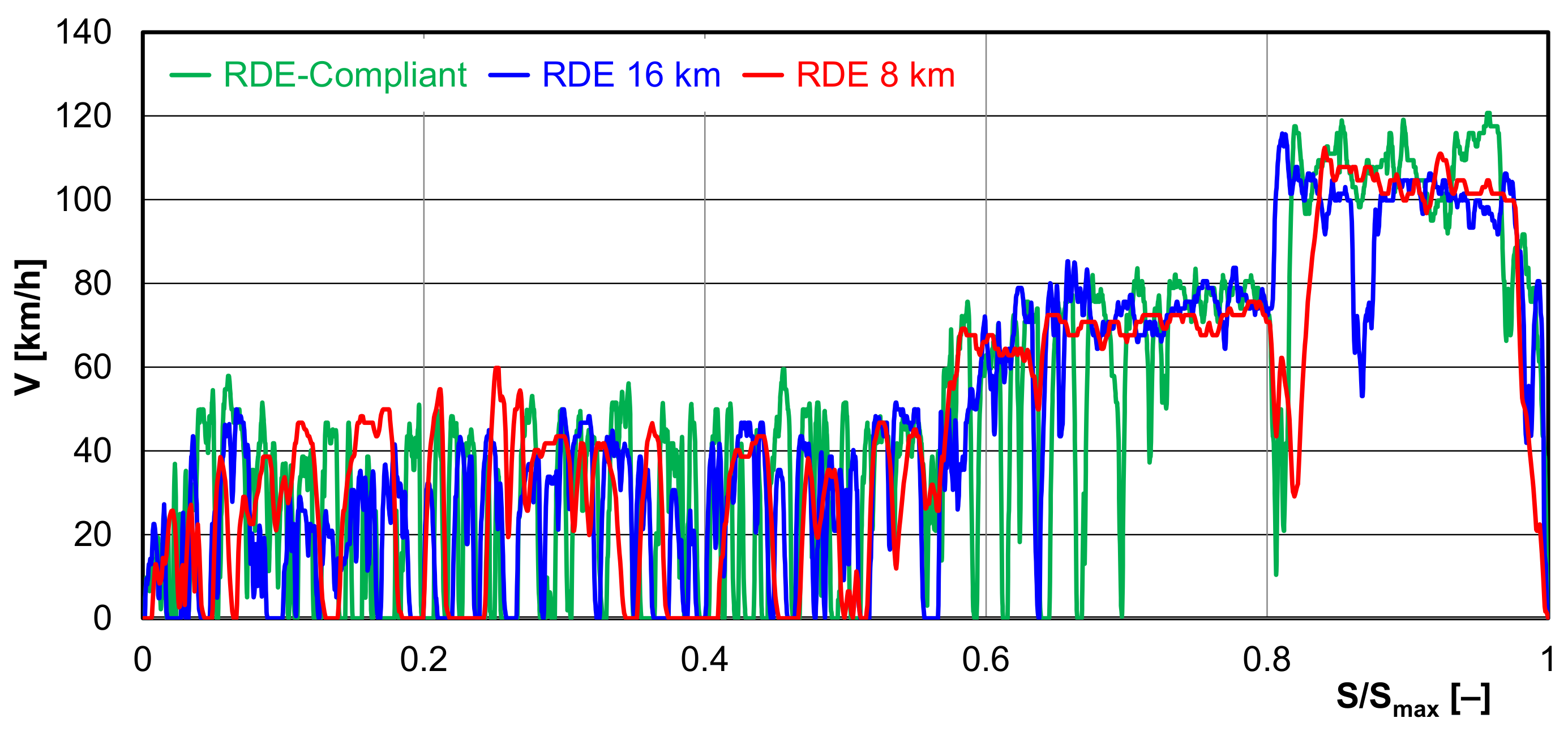

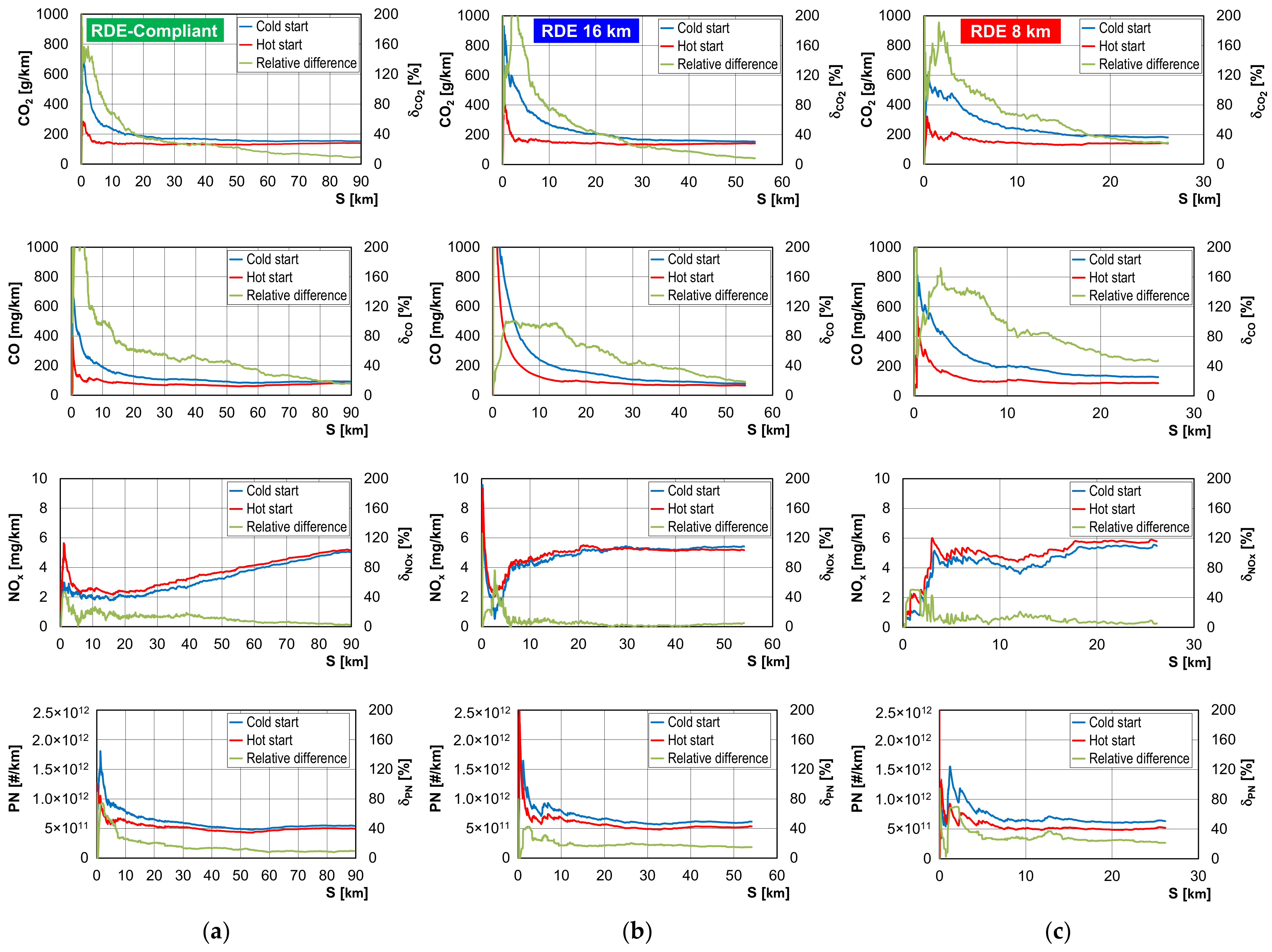
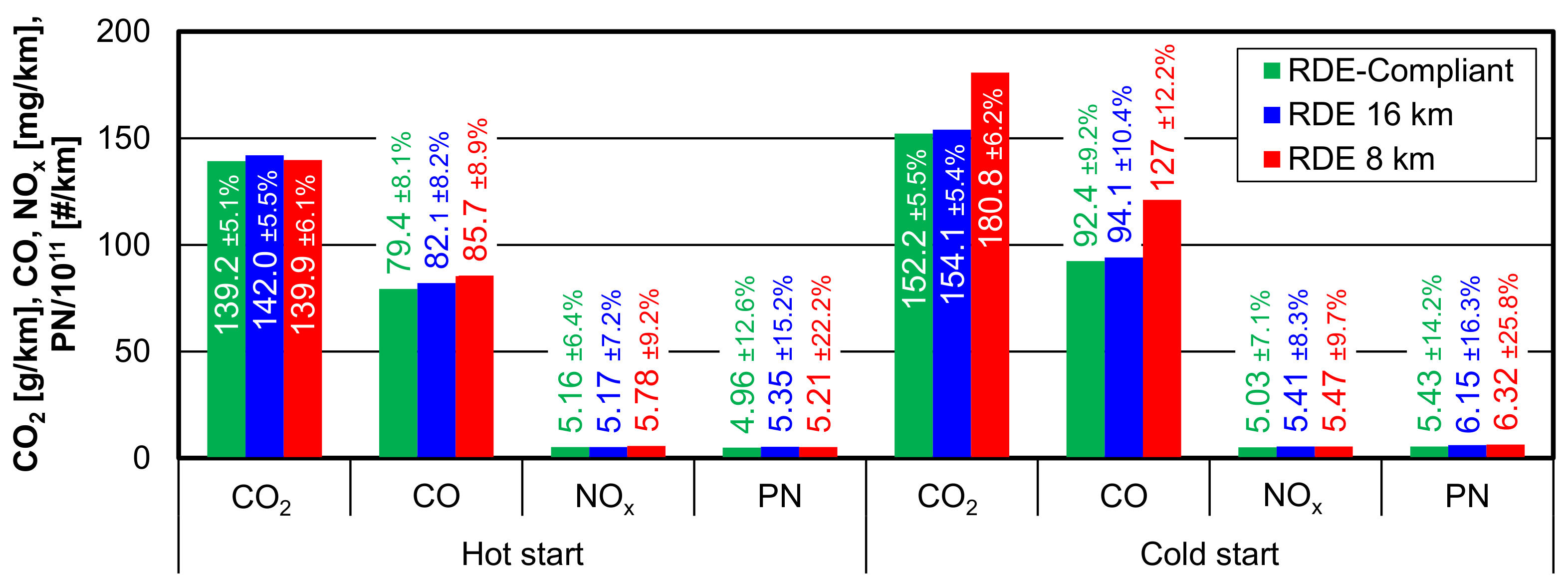
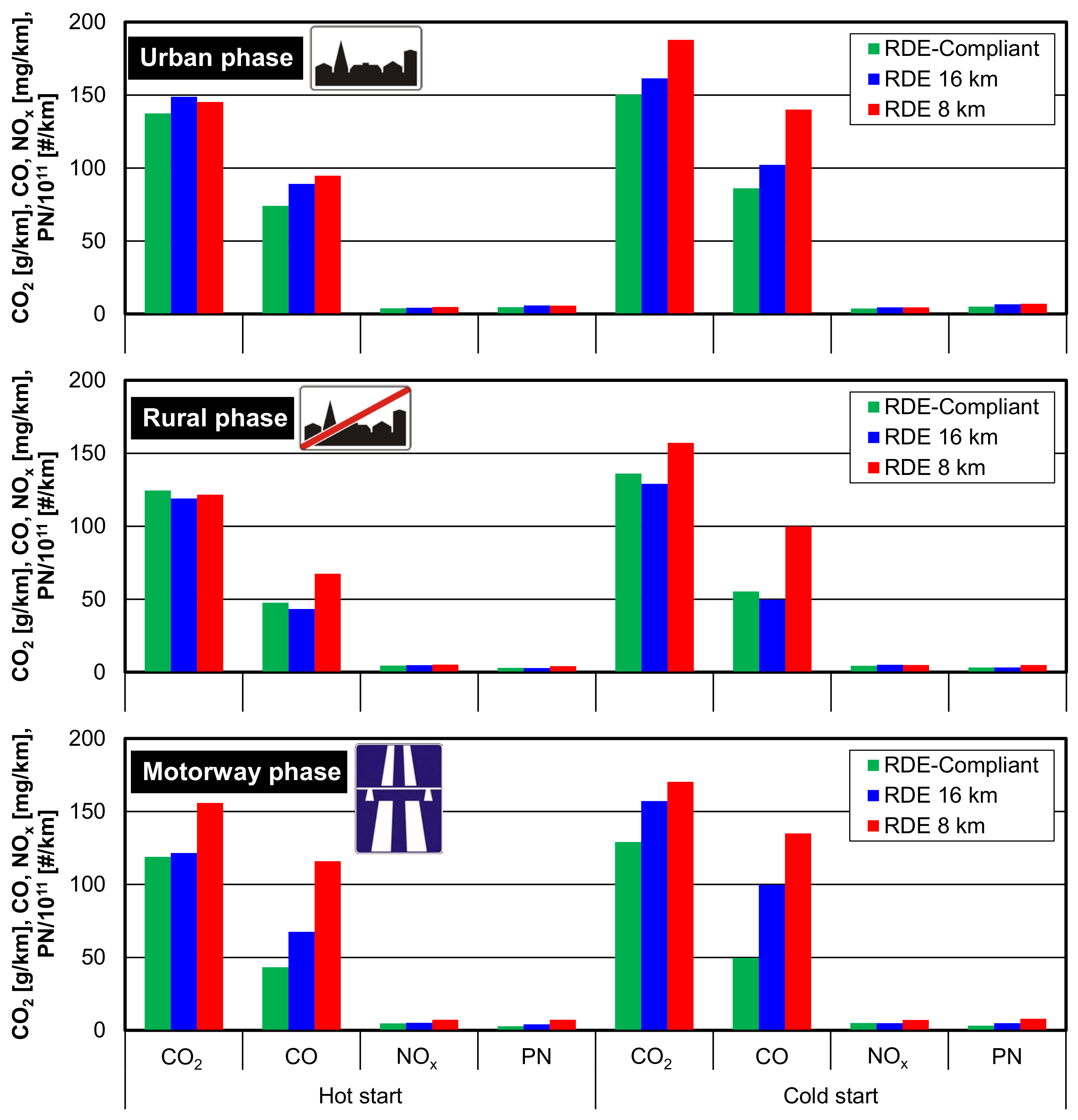
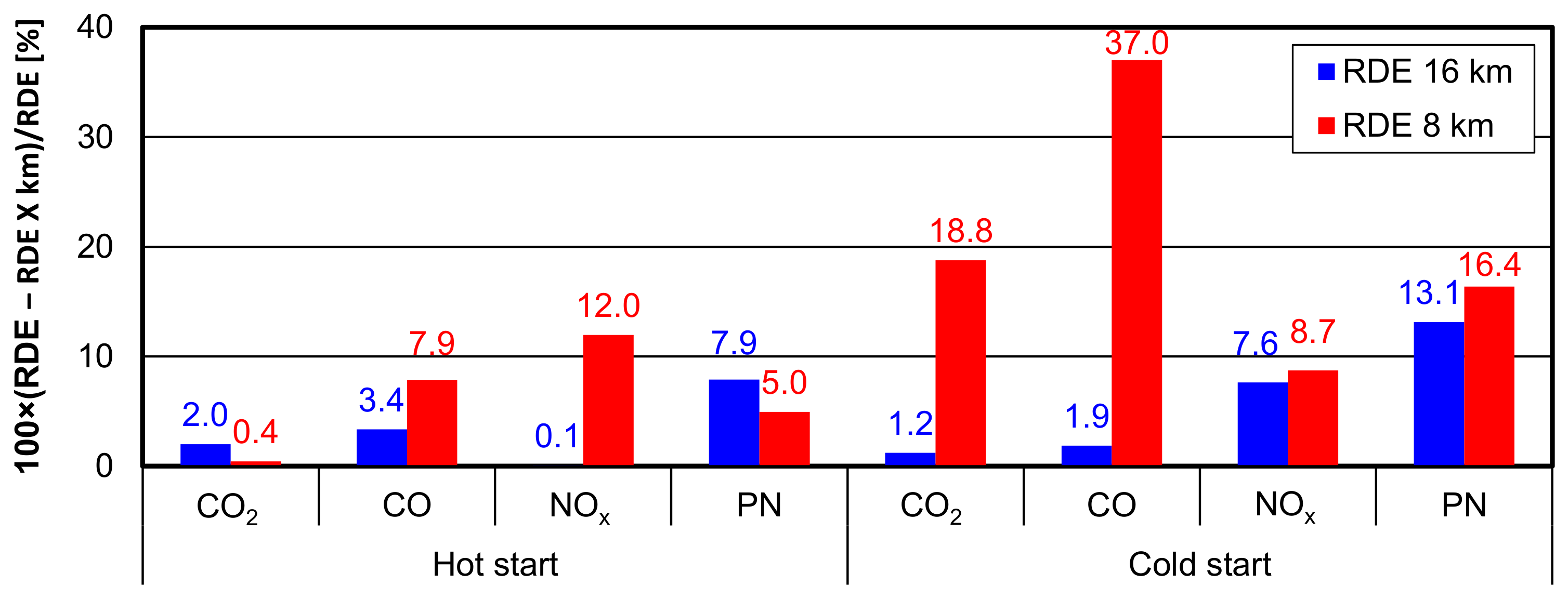

| Requirements | RDE-Compliant | RDE 16 km | RDE 8 km |
|---|---|---|---|
| Distance | |||
| Urban | >16 km (30 ± 5 km) 1 | 16 ± 3 km | 8 ± 2 km |
| Rural | >16 km (30 ± 5 km) 1 | 16 ± 3 km | 8 ± 2 km |
| Motorway | >16 km (30 ± 5 km) 1 | 16 ± 3 km | 8 ± 2 km |
| Trip composition | |||
| Urban | 29–44% | 29–44% | 29–44% |
| Rural | 23–43% | 23–43% | 23–43% |
| Motorway | 23–43% | 23–43% | 23–43% |
| Average urban speed | 15–40 km/h | 15–40 km/h | 15–40 km/h |
| Stop (urban driving time) | 6–30% | 6–30% | 6–30% |
| Dynamics | |||
| 95th percentile v·a+ | 95th percentile of the multiplication of the instant speed and positive acceleration signals as defined in [11] | ||
| Relative positive acceleration (RPA) | Relates to the relative positive acceleration as defined in [11] | ||
| Total trip duration | 90–120 min | 60–90 min | 30–60 min |
| Technical Parameters | Hybrid Vehicle |
|---|---|
| Model year | 2021 |
| Engine | Gasoline, Line 4, 16V |
| Engine displacement | 2.5 L |
| Aftertreatment system | three-way catalyst |
| Maximum power | 130 kW (combustion engine) + 30 kW (electric engine) |
| Maximum torque | 220 Nm/3600–5200 rpm (combustion engine) + 30 Nm (electric engine) |
| Transmission | automatic |
| Curb weight | 1590 kg |
| Average CO2 emissions | 132 g/km (WLTC) |
| Euro standard | Euro 6d-temp |
| Mileage | 36,000 km |
| Battery | 11 kWh |
| Description | Measurement Method | Range | Accuracy of the Measurement Range |
|---|---|---|---|
| CO | NDIR | 0–10% | ±3% |
| THC | FID | 0–10,000 ppm | ±2.5% |
| NOx (NO + NO2) | NDUV | NO: 0–2500 ppm NO2: 0–500 ppm | ±3% |
| CO2 | NDIR | 0–20% | ±3% |
| O2 | Chemical analyzer | 0–22% | ±1% |
| Frequency | – | 1–4 Hz | – |
| Exhaust flow | Mass flow rate | 0–500 kg/h | ±1% |
Publisher’s Note: MDPI stays neutral with regard to jurisdictional claims in published maps and institutional affiliations. |
© 2022 by the authors. Licensee MDPI, Basel, Switzerland. This article is an open access article distributed under the terms and conditions of the Creative Commons Attribution (CC BY) license (https://creativecommons.org/licenses/by/4.0/).
Share and Cite
Skobiej, K.; Pielecha, J. Analysis of the Exhaust Emissions of Hybrid Vehicles for the Current and Future RDE Driving Cycle. Energies 2022, 15, 8691. https://doi.org/10.3390/en15228691
Skobiej K, Pielecha J. Analysis of the Exhaust Emissions of Hybrid Vehicles for the Current and Future RDE Driving Cycle. Energies. 2022; 15(22):8691. https://doi.org/10.3390/en15228691
Chicago/Turabian StyleSkobiej, Kinga, and Jacek Pielecha. 2022. "Analysis of the Exhaust Emissions of Hybrid Vehicles for the Current and Future RDE Driving Cycle" Energies 15, no. 22: 8691. https://doi.org/10.3390/en15228691








